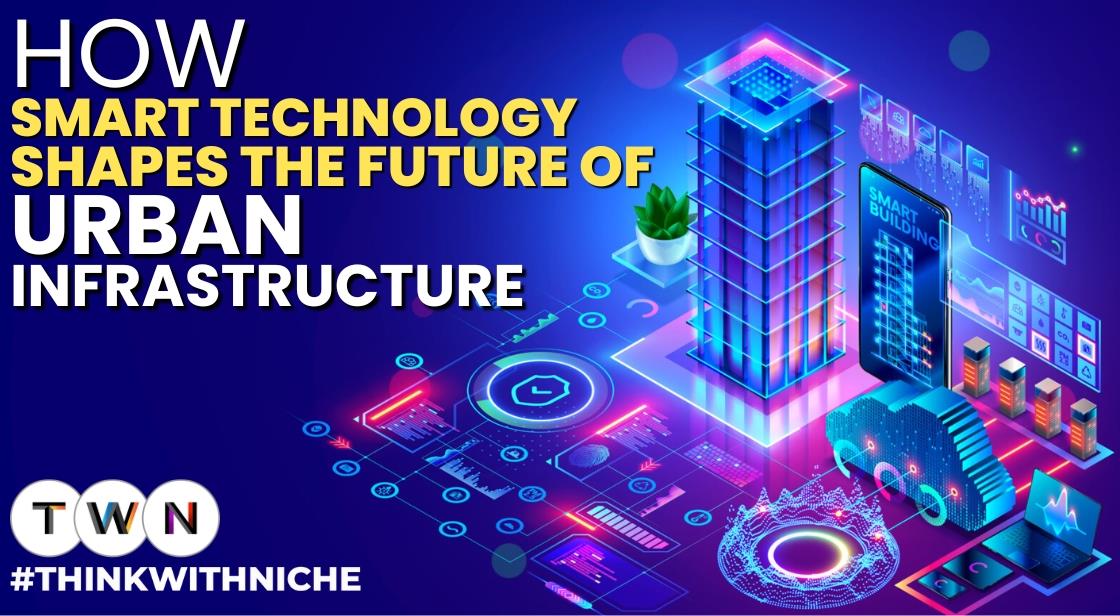How Smart Technology Shapes the Future of Urban Infrastructure

Blog Post
Urbanization is reshaping the world at an unprecedented pace, bringing both remarkable opportunities and pressing challenges. Cities, as the epicenters of human activity, are witnessing rapid growth, but this expansion places immense pressure on their infrastructure.
From crumbling drainage systems to outdated transportation networks, urban areas face a critical need for transformation to accommodate modern demands and ensure sustainability.
As cities grow, the strain on resources and systems becomes evident, highlighting the need for innovative solutions and strategic investments. The future of urban infrastructure depends on three critical pillars: visionary leadership, advanced technology, and effective collaboration.
Together, these elements hold the potential to not only address existing challenges but also pave the way for sustainable, resilient, and future-ready urban spaces.
In this blog, we explore how strong leadership drives impactful decisions, how cutting-edge technology is revolutionizing urban infrastructure, and how public-private partnerships create synergy for innovative solutions.
By examining these key factors, we aim to highlight the path forward for urban development in a rapidly changing world. Whether it’s tackling traffic congestion, enhancing water management systems, or fostering sustainable growth, the decisions made today will shape the cities of tomorrow.
Smart Technology Driving Urban Infrastructure Evolution
The Rapid Growth of Cities and the Need for Innovative Infrastructure
Cities around the world are expanding at unprecedented rates, leading to increased strain on infrastructure systems. From deteriorating drainage systems to outdated technology, urban areas face growing challenges to meet the demands of modern living.
The need for fresh ideas and substantial investments is urgent. Policymakers and business leaders must tackle these challenges head-on to create sustainable, efficient, and future-proof urban spaces.
Urban infrastructure requires a complete transformation, one that incorporates modern technologies, strategic leadership, and effective collaborations. These three pillars provide the foundation for developing cities that can not only address today’s challenges but also adapt to future needs. Let’s explore how leadership, technology, and partnerships are driving change in urban infrastructure.
The Role of Leadership in Shaping Urban Infrastructure
Leadership’s Influence on Decision-Making
Leadership plays a pivotal role in determining the success of infrastructure projects. Strong leaders take bold steps to ensure that projects address current urban issues while being prepared for future challenges. They prioritize sustainability, long-term planning, and innovation. By aligning projects with these values, leaders ensure infrastructure serves communities effectively for decades.
For instance, the World Economic Forum highlights how inclusive leadership can turn sustainability from a concept into a tangible outcome. Leaders who bring together diverse stakeholders—government officials, businesses, and community representatives—create more resilient cities. These collaborations foster long-term strategies that benefit both people and the environment.
Case Studies of Effective Leadership
Effective leadership goes beyond mere project management. Visionary leaders see infrastructure projects as opportunities for transformative change. By focusing on eco-friendly solutions, they address the immediate needs of urban areas while minimizing environmental impact. Examples include:
-
Eco-friendly transportation networks: Implementing electric public transit systems to reduce emissions.
-
Green building initiatives: Mandating sustainable practices in construction to conserve resources and energy.
Business leaders also play a crucial role. Companies that invest in sustainable infrastructure often pave the way for innovation and economic growth, creating a win-win scenario for both businesses and urban residents.
Incorporating Advanced Technology in Infrastructure
The Impact of Technology on Urban Systems
Technology is revolutionizing urban infrastructure by providing smarter, more efficient solutions to long-standing problems. From traffic management to water conservation, advanced tools and designs are helping cities address the complexities of modern life. Companies like Vodaland demonstrate how innovation can transform infrastructure. For example, their EasyPave system enhances groundwater management by allowing rainwater to seep into the ground, reducing the risk of flooding.
Challenges of Integrating Technology
While the benefits of technology are clear, implementing these solutions often faces hurdles:
-
Aging Infrastructure: Many cities operate with outdated systems that are incompatible with modern technologies. Retrofitting these systems requires significant investment and planning.
-
Regulatory Barriers: Municipal codes and outdated regulations often hinder the adoption of innovative designs and practices.
Despite these challenges, forward-thinking companies and city planners are overcoming obstacles by:
-
Introducing modular, scalable systems that integrate seamlessly with existing infrastructure.
-
Advocating for policy changes that support technological innovation.
The Role of Smart Cities
The rise of smart cities illustrates how technology can redefine urban infrastructure. Using IoT (Internet of Things) devices, sensors, and data analytics, smart cities optimize resource allocation, improve public services, and enhance quality of life. Examples include:
-
Traffic Management Systems: Using AI to reduce congestion and optimize public transit schedules.
-
Energy-Efficient Grids: Smart grids that balance energy supply and demand, integrating renewable energy sources seamlessly.
Public-Private Partnerships: A Key to Urban Transformation
The Value of Collaboration
Collaboration between public and private sectors is crucial for large-scale infrastructure projects. Public-private partnerships (PPPs) bring together the resources, expertise, and innovation of both sectors, creating sustainable and cost-effective solutions.
PPPs align the goals of the public sector, such as improving quality of life, with the efficiency and funding capabilities of the private sector. These partnerships address funding gaps and encourage innovative approaches to infrastructure development.
Successful Examples of PPPs
Effective PPPs are built on shared goals and mutual benefits. Examples include:
-
Transportation Projects: Collaborative efforts to build metro systems, reducing urban traffic and pollution.
-
Smart Water Management: Partnerships to create sustainable water supply systems that address both urban and rural needs.
-
Energy Initiatives: Joint ventures in renewable energy projects, such as solar and wind farms, that provide clean energy to cities.
By pooling resources and expertise, PPPs lead to projects that are better designed, more innovative, and faster to implement.
Also Read: How Machine Learning Is Revolutionizing The Way We Deliver Customer Service
Overcoming Challenges in PPPs
While PPPs offer significant benefits, they are not without challenges:
-
Complex Agreements: Negotiating terms that satisfy both public and private interests can be time-consuming.
-
Risk Sharing: Balancing risks between sectors requires careful planning and clear communication.
Despite these obstacles, successful PPPs demonstrate the power of collaboration in achieving infrastructure goals that serve the greater good.
Urban Growth as a Catalyst for Innovation
Challenges of Rapid Urbanization
Urban growth poses significant challenges, including overcrowding, traffic congestion, and strain on resources. However, these challenges also create opportunities for innovation:
-
Developing smarter drainage systems to manage increased rainfall and prevent flooding.
-
Implementing green spaces and parks to improve urban living conditions.
-
Enhancing public transportation to reduce dependence on private vehicles.
Opportunities for Businesses and Communities
Businesses have a unique opportunity to drive innovation in urban infrastructure. By investing in sustainable solutions, companies can:
-
Create products and services that address urban challenges.
-
Position themselves as leaders in the infrastructure industry.
-
Contribute to long-term economic and environmental sustainability.
For communities, these innovations mean improved quality of life, reduced environmental impact, and more resilient cities.
The Future of Urban Infrastructure
Choices that Shape Tomorrow’s Cities
The decisions made today will define the cities of tomorrow. Strategic investments in leadership, technology, and partnerships are crucial to creating infrastructure that meets modern needs and anticipates future demands.
Building Resilient Cities
Resilient cities prioritize adaptability, sustainability, and community well-being. This involves:
-
Smart Design: Incorporating technology to optimize infrastructure efficiency.
-
Sustainable Practices: Reducing environmental impact through eco-friendly materials and methods.
-
Inclusive Collaboration: Engaging diverse stakeholders to create solutions that serve all members of society.
The Role of Leadership in Sustainability
Leadership remains at the forefront of this transformation. By prioritizing sustainability and innovation, leaders can:
-
Ensure infrastructure investments have long-term benefits.
-
Foster collaborations that pool resources and expertise.
-
Inspire communities to support and adopt new solutions.
Conclusion
As urbanization accelerates, the demand for innovative, sustainable, and resilient infrastructure becomes paramount. The future of urban spaces lies in the hands of visionary leadership, the adoption of smart technologies, and the collaborative efforts of public-private partnerships.
These pillars not only address the immediate challenges of modern cities but also create long-term opportunities for growth, sustainability, and an improved quality of life for urban populations.
By prioritizing strategic investments, fostering eco-friendly solutions, and embracing cutting-edge technologies, cities can overcome the obstacles of aging systems and prepare for the demands of the future. The choices made today will shape the cities of tomorrow, transforming them into thriving, inclusive hubs of innovation and sustainability.
Business leaders, policymakers, and stakeholders must act decisively and collaboratively, ensuring that urban infrastructure evolves to meet the needs of a rapidly changing world.
The path forward is clear: it’s not just about solving problems but about creating a vision for the future. Together, leadership, technology, and collaboration can build smarter cities that stand as a testament to human ingenuity and the collective commitment to a sustainable and prosperous future.
You May Like
EDITOR’S CHOICE












